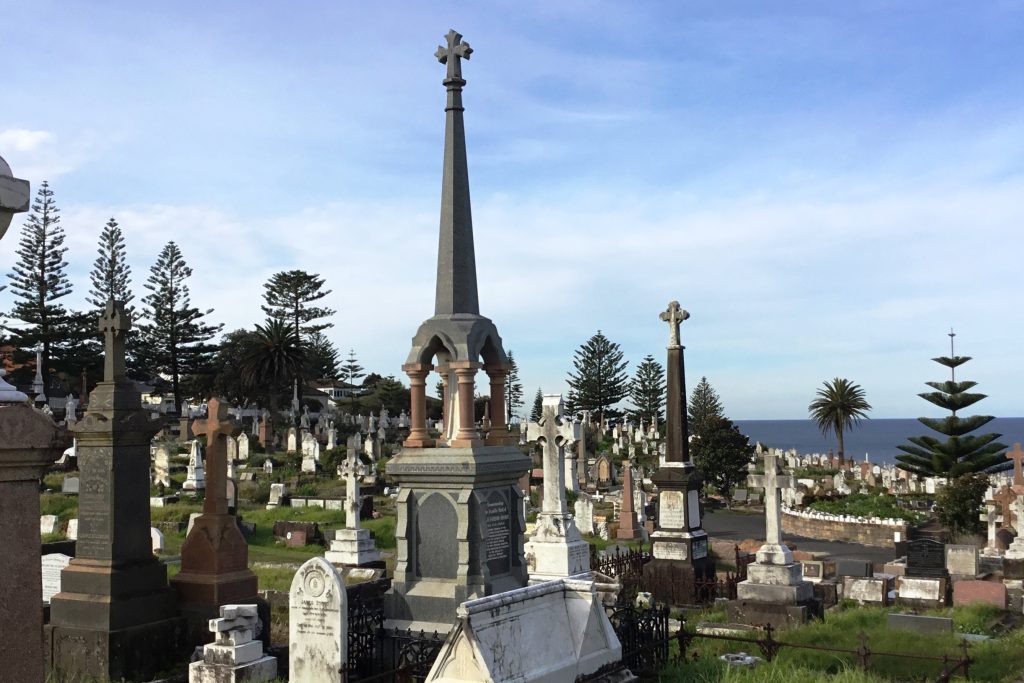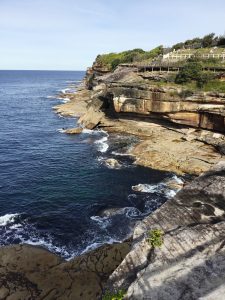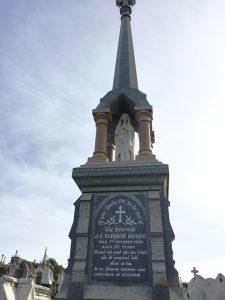
With Fr Julian Tenison Woods’ anniversary of death on 7 October, I am drawn to reflect on a visit I made to his grave at Waverley Cemetery [1] earlier this year.
Perhaps it was because the weather was so good that day that I followed a sudden impulse to travel across Sydney by train and bus with only my phone as a guide. When I entered the gates of the cemetery, I was amazed to see so many headstones spread out across the hillside below me. The further I walked the more I felt enfolded by so many stories from the past.

The first burial at Waverley Cemetery occurred in August 1877. Being located on the cliffs bordering the Pacific Ocean, the area soon became a very popular last resting place. Today it is a place of beautiful remembrance for over 100,000 people, many of whom were famous in their own time including Henry Lawson, Henry Kendall, Dorothea McKellar (poets) William Dalley (statesman and patriot), William Dymock (bookseller) Jack Fingleton (cricketer and journalist), Gwen Plumb (Blue Hills) and, of course, Fr Julian. The cemetery is very well laid out and many walkers pass it as they tread the clifftop Bondi to Coogee Coastal Walk.
Knowing at least what Fr Julian’s monument looked like, I headed down the hill only to be very surprised to see one of the same design, although the granite was yellowish, commemorating the memory of Mary Ann, Bridget and William Lupton who died in 1891, 1917 and 1919 respectively. Another of the same design, minus the statue of Mary, commemorated Watson Braithwaite (1912). I also noticed a similar design in white marble in memory of the Moss family. My curiosity led me to later research monumental masons of the late 19th century and I established that there were at least 13 located around Waverley Cemetery in the 1890s. The name inscribed at the base of Fr Julian’s memorial, Flanagan & Anderson, may indicate which firm completed the work. Pattern books based on European designs were often used to assist with choice of memorials. [2]
Around this time, it was also customary to raise money by public subscription to cover costs. With Fr Julian, the esteem in which he was held by the scientific community resulted in the collection of monies to erect a fitting memorial with words to mark his contribution as priest, scientist and founder of religious congregations.

When I did eventually find Fr Julian’s gravesite, I was struck by what it said to me about his life: a cross to tell of his love of Christ as well as marking his own suffering, a statue of Mary, his beloved Mother, a book, maybe a bible, with the words “God’s will be done”, declaring his love of Scriptures and prayer and trust in the Providence of God.
Sitting there in the sunshine, I became aware of the insects enjoying the warmth, the birds singing in the trees around me and the sheer beauty of the place. I was reminded of Fr Julian’s words: God’s beauty, goodness and watchful care of me and all nature pursues me everywhere.
All created things were certainly giving me a glimpse of the beauty of the Creator that day.
I wondered what Fr Julian might say to us today. Perhaps,
Look around you and delight in God’s presence wherever you are, whatever you are doing. Use your gifts for others so that you can relieve suffering and bring hope to all of creation. You are a beloved instrument in the hands of God so let God work through you for God is your Way, your Truth and your Life.
Carmel Jones rsj
Footnotes:
[1] https://www.waverley.nsw.gov.au/cemeteries
[2] One reference that caught my interest was a PhD thesis written by Lisa Anne Murray at the University of Sydney, August 2021: Cemeteries in Nineteenth-Century New South Wales: Landscapes of Memory and Identity https://ses.library.usyd.edu.au/handle/2123/16784
[3] Letter, Julian Tenison Woods to Mary MacKillop January 1870
[4] Introduced and annotated by Margaret Press rsj – first published by Harper Collins 1997 page 238
